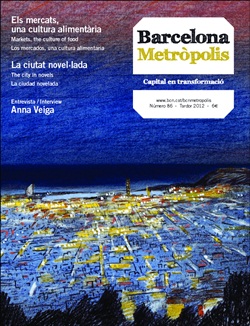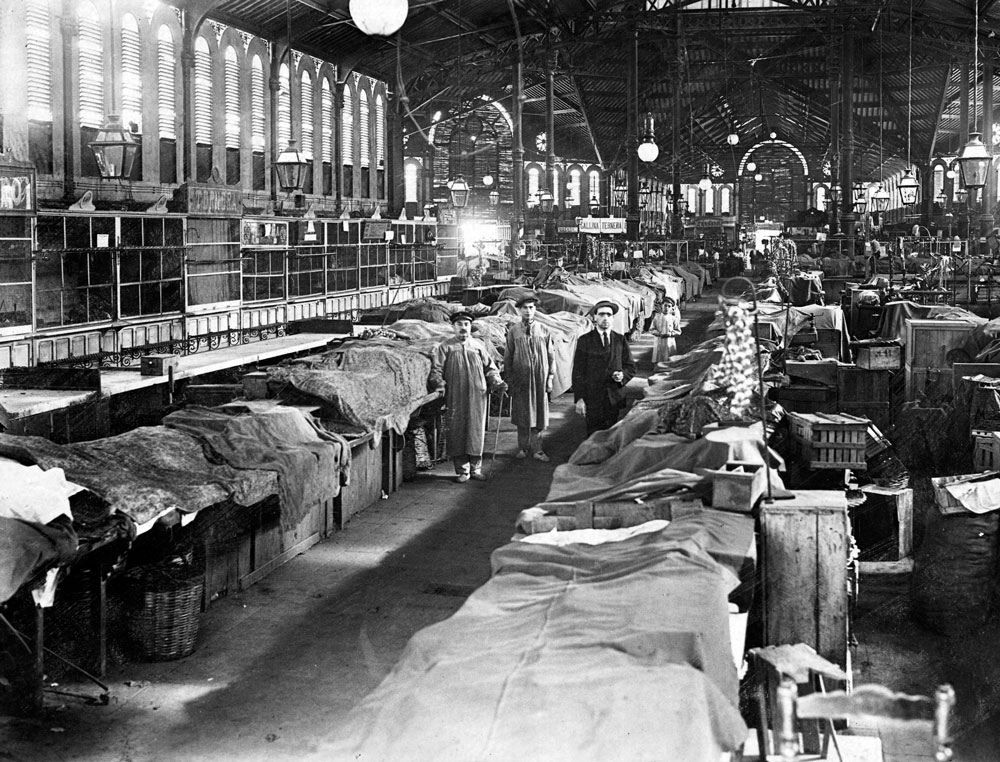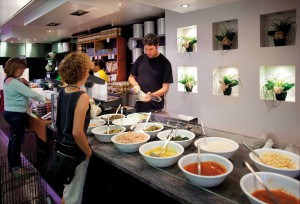The local politics during the Spanish democracy in matters of markets policy has set trends and Barcelona –the leading member and seat of the international markets association Emporion– has served as a model for other cities.
As Lewis Mumford said in The City in History, a large part of the history of cities may be explained by the implementation of commercial activities in the territory. Commercial structures – more particularly market sites – largely condition urban structures.
Barcelona is no exception in this regard. Professors Manuel Guàrdia Bassols and José Luis Oyón Bañales estimate that the origin of these commercial facilities dates back to the 10th century, through the incipient concentration of sellers in open squares. Since then, these spaces have evolved with the city. Urban growth in Cerdà’s Eixample required new spaces for facilities and particularly markets, which helped to structure the emerging districts. At the same time, the inclusion of the municipalities of the plain of Barcelona, which had their own markets, within the city’s limits, heralded, at the beginning of the 1930s, a territorial organisation of the commercial apparatus that made it possible to begin to regard Barcelona’s markets as a structured network.
With the economic and urban recovery of the post-war period, halfway through the 1960s a new phase began in the construction and operation of municipal markets. In the districts that sprang up following the waves of immigration, markets began to appear, where the City Council chose new channels of development and commissioned the building and assignment of stands to private enterprise. Despite this kind of development, the new markets went on to become part of the public network. In the absence of control by the democratic institutions, nepotism, conflicts of interest and the buying and selling of favours took hold of the municipal markets. In 1956 the Head of the Trade Union of Poultry, Egg and Game Products addressed the “powers that be”, requesting a change in Barcelona’s municipal bylaws in the following terms: “The reasons that lead us to ask for these modifications are […] the acknowledgement of our existence as an independent group within the livestock union, with its clear and specific name of pollería, huevos y caza [poultry, egg and game products]. This is why it is logical and easy to understand that we are exclusively the SOLE AGENTS authorised to sell these goods […]”
These brushstrokes of history provide us with an introduction to the knowledge of market policy – one of the core axes of the management system that gave rise to the so-called “Barcelona model” –, which has had two main aspects: the architectural and functional restructuring of facilities and the development of common methods of management and promotion applied to markets overall regarded as a network.
“It is forbidden to shout out the kind of goods and prices and call to shoppers.” Thus reads the beginning of article 136 of the Municipal Bylaws on markets in force in 1979, when the first democratic city council was constituted. At that time, the administrative “legacy” placed the management of municipal markets within a strict management framework of administrative licences and services. Markets were managed in the same way as cemeteries, concessions for beaches, public bathrooms and toilet services. They were regarded as public spaces granted for private economic activities and which required no intervention other than the application of iron discipline to bring some order to the sectors represented by the different guild branches of the vertical trade union.
The arrival of the new town and city councils coincided with the economic crises of the late 1970s. The difficult management of this crisis had the undercurrent of industrial restructuring, spawning a spate of layoffs in industries in Barcelona and the metropolitan area. For many years commercial activities had acted as a buffer for unemployment. When employment in industry or the building trade waned, the number of small commercial units would grow. Money from severance packages was reinvested in opening shops in sectors requiring less investment, and purportedly less expertise, such as food stores.
At the same time, the situation in the real estate market was paradoxical: in times of crisis a huge real estate invest-ment had been made to capitalise on the remaining opportunities of the former city planning laws, which were soon superseded by the enactment of the General Metropolitan Plan. The outcome is easy to guess: scores – if not hundreds – of buildings were erected to try to get round the new planning, which afforded the city green spaces and amenities. This led to a surplus supply of large ground-floor commercial premises, the consequence being a heightening in the lack of demand typical of as yet underdeveloped shopping structures lacking investment capacity.
Real estate developers found a solution for their unsold premises: “divide them into plots” – small premises which they sold off to people with small investment capacity (those laid off from industry who were reinvesting their severance packages into self-employment in commerce). In this way, a large number of private food halls sprang up, lacking prevision or planning, seeking to emulate the municipal markets. This practice of plot division, which the French very graphically call saucissonner [chopping up the sausage], meant that each premises was allocated to the activity the shopper wanted. Hence there was no discipline, because the marketing mix had not been planned (a mix of uses weighted according to family needs), and nor was there any possibility of joint management and commercial promotion.
The indiscriminate appearance of food shops was a threat to the proper operation of the municipal market network. The City Council embarked upon the regulation of the sector by means of a bylaw for food halls, food centres and supermarkets. The fundamental criterion of this bylaw was the setting of a minimum distance between establishments. This bylaw was contested in the courts; the ruling found in favour of those affected, and it was revoked as illegal.
However, at the same time, the ruling indicated that planning had to be executed through a special urban development plan. Thus, the councillor for Municipal Services, Josep Maria Serra i Martí, and the Area Director, Jordi Maymó, promoted the Pla Especial del Comerç Alimentari de Barcelona [Barcelona Special Food Shopping Plan – PECAB], which was drafted in our office.
The formulation of the PECAB was preceded by a set of studies on the municipal markets. Particularly noteworthy is a survey on the appeal of markets and where the shoppers came from. The results took the material form of a map that reflected the areas where the families that shopped at each market lived. Two conclusions may be drawn: firstly, the importance of local shopping; secondly, the existence of areas not covered by the municipal markets, some of them corresponding to the industrial areas of Poblenou, Bon Pastor and Zona Franca, and others to free areas such as Montjuïc, Tres Turons, Ciutadella or Collserola. Finally, and this is the most salient point, there are facility shortcomings in major residential areas such as Fort Pienc, Pedralbes, some areas of Nou Barris and a large area between the Eixample and Sants.
The PECAB’s main objective – which has been maintained after two revisions – is to plan the city’s commercial activity in terms of location, in accordance with identifiable behaviour patterns and more general urban development patterns. In this context, the PECAB’s main contribution was to conceive the city planning structure of the food shopping trade as a network with primary nodes, namely the municipal markets.
Once the areas lacking coverage had been detected, the plan proposed a structuring of commercial locations based on three major axes:
1) The areas of commercial polarity operating around the pre-existing municipal markets that acted as a focal point of this polarity. The activities envisaged for the surrounding areas were based on urban development and the planning of commercial structures. The role of markets as a driving force was acknowledged, but at the same time it sought to prevent the appearance of inefficient parasitical structures that exploited the market’s appeal.
2) The areas where shortcomings were detected in the services of the municipal markets, which we called “areas of new commercial polarity”, that permitted the implementation of new facilities in the form of municipal markets, shopping centres with the presence of food shops or large supermarkets.
3) The local shopping areas, spread all over the city, where only small establishments were allowed.
From local to central
Municipal markets, like other commercial formats, are governed by the principles of commercial location: they must generate centrality and promote the values of localness, as spaces for social interaction and cohesion. This twofold aspect was addressed by the City Council as soon as Barcelona was awarded the 1992 Olympic Games.
The Pla d’Àrees de Nova Centralitat [New Centrality Areas Plan], which established up to 12 points of urban development intervention, was the necessary complement to the PECAB. All the main operations addressing centrality of trade and tertiary services implemented in Barcelona since 1990 have been driven by this municipal proposal.
One of the distinguishing features of the “Barcelona model” was the promotion of proximity to facilitate residents’ shopping habits, while also promoting a centrality that made these facilities attractive for shoppers, thereby ensuring the profitability of the businesses. As soon as the city structure for the location of shops was established, and the pre-eminent role of markets was embedded in the distribution network, the reform of these facilities was addressed, underpinned by four key principles:
1) Modernisation of commercial structures. This meant taking action with regard to formats, products that could be sold at each stall, the inclusion of new ranges of products, presentation and dining. The evolution in the eating habits of Barcelona’s families is well-represented in the markets. The progressive importance attached to healthy diets affords priority to fresh food, epitomised in the markets. The growing complexity of industrial relations often obliges families to eat out in public restaurants; hence the implementation of eating facilities in municipal markets comes in response to the extension of new ways of working and timetables.
2) Improvement of operators’ economic efficiency. It seemed that it would not be possible to sustain the municipal markets without guaranteeing a sufficient level of income, which required, besides specialisation, a reduction in the number of stalls and an increase in the average surface area.
3) Application of the “one stop shop”. Thus, places for the sale of dry food and household and perfumery products on a self-service basis were introduced into markets; in this way, supermarkets were like any other operator.
4) Last but not least, physical intervention in markets to renovate the facilities, introduce new services and restructure internal circulation, while maintaining the original structures as far as possible.
Some examples of the application of these principles in reformation processes include the new Sagrada Família market, the first one to have a supermarket within its structure; the Santa Caterina market, given a major overhaul in view of the existence of stonemasonry building structures that rendered it necessary to build a new roof, and which have made it a must-visit spot in the city; the Clot and Llibertat markets, which have cut the number of operators and conserved the magnificent iron structures; the Boqueria market, which added new services and facilities and where work was carried out to guarantee the comfort of clients and sellers alike; and the Sant Antoni market, with an ongoing reform intended to turn it into a true shopping centre, with a range of non-food shops.
Social trends
The policies of the democratic town and city councils for municipal markets are truly groundbreaking, leading many cities to look upon Barcelona – which leads and is the headquarters of the international association of municipal markets, Emporion – as a role model.
The range of municipal markets is the best example of new diet trends. The concept of the “Mediterranean Diet” developed progressively towards the broader concept of slow food, as opposed to fast food (with unbalanced diets), which also attaches value to local agricultural products –products which by no means find it easy to break into the large commercial corporations.
Municipal markets are a reference for a burgeoning Barcelona and Catalonia in terms of gastronomy, and denote how people appreciate things local, facilitating social relationships, promoting sustainability and protecting the environment. They are also an important factor in social cohesion. Here is a very graphic example. During a conference on immigration and trade held in 2007, the owner of an offal stall in the Boqueria market explained that following the Mad Cow Disease crisis, consumption had plummeted to the point where such stalls had all but disappeared. However, all of a sudden, the growth of immigration from Latin America sparked an increase in consumption, giving these stalls a new lease of life, employing people from these countries as experienced workers.
Finally, it should be remembered what the market represents for the elderly. The clients who go there first thing in the morning – hardly compatible with working hours – are basically the elderly, who live alone and for whom the market stalls provide their focal point of social interaction.
Recently, the Board of Commerce and Consumption of the City Council conducted a study on shopping habits from which it may be deduced that municipal markets are still the main place where people buy fresh food. From 1985 on, a fall had been recorded in the capture of clients, which has been curbed since 1997.
Nowadays, markets retain a share of 40% of fresh food shopping, whereas a progressive fall in the share of the hypermarkets has been detected. The same study shows that 90% of food purchases are made in the district where one lives, and that 55% of families from Barcelona go to the market at least once a week.






